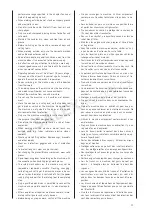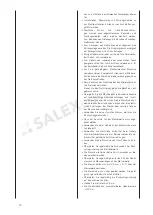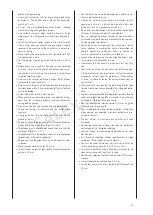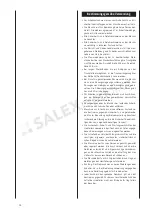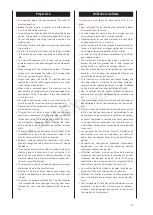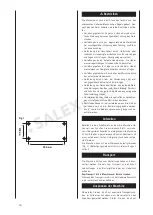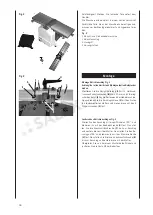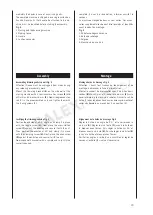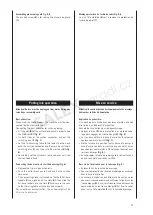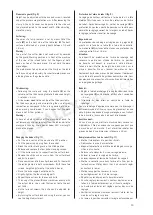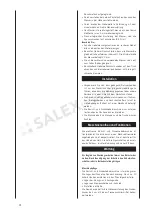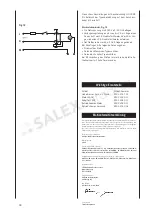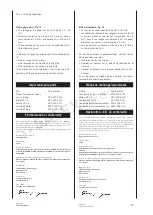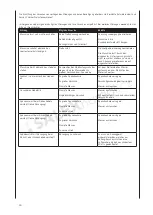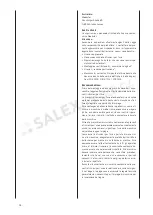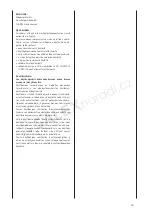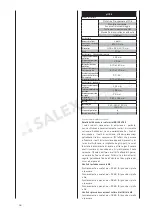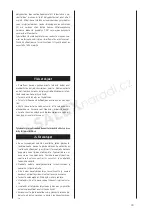
25
• The knife is exactly set, when the ruler is moved by the
knives not higher than 3 mm.
• After a successful knife setting, all clamping screws
must be tightened (8.4 N/m).
Please mind:
• Sharp planer/thicknesser knives guarantee a clean plan-
ing surface and put less stress on the motor.
• Observe all knifes to have the same width (unbalance),
when finish-grinding. The minimum width of the knifes
is 20mm.
• The planer/thicknesser blades used on this machine are
not suitable for rebating and dovetailing.
• Finally lower the cutter block guard again onto the ta-
ble. Cover the cutter block and block it with the star grip
screw.
Installation
• Make sure there is sufficient space for handling the
work piece over the whole length without the operator
(or another person) having to stand in line with the work
piece.
• Using bolts, washers and hexagon nuts (not supplied
with the machine), the planer/thicknesser can be bolted
to a work bench.
• The planing machine must be bolted onto a firm, level
surface.
• The machine may not tilt, and the table must be
aligned.
Machine setting up and functions
The electric planer/thicknesser is transportable. It is pow-
ered by a single-phase motor and is double insulated. It
has been designed for planing wood, and it features a ra-
tional construction, easy operation, and high efficiency.
Maintenance
Always pull the power supply plug before doing any servic-
ing work. Having finished the work, put the cutter block
guard in operating position again.
Machine care
The planer/thicknesser requires little maintenance. The
ball bearings are permanently lubricated. After approx.
ten operating hours, lubrication of the following parts is
recommended:
• Bearing of the infeed and output roller
• Bearing of pulley and sprocket
• Greasing the chain.
The threaded spindle for height-adjustment of the thick-
nessing table may only be treated with a dry lubricant
agent.
les lames pas plus de 3 mm.
• Ensuite, reserrer toutes les vis fermément (8,4 N/m).
Faire attention:
• Ne travaillez qu'avec des lames bien affûtées. Elles dé-
chargent le moteur et garantissent une surface lisse.
• Lors du repassage, veiller à ce que toutes les lames
aient la même largeur (charge déséquilibrée). La largeur
minimale des lames est de 20 mm.
• Les lames usées sur cette machine ne sont pas appro-
priées à entailler en queue d’aronde.
• Finalement abaisser la protection de l'arbre de rabotage
sur la table, couvrir l'arbre et le serrer avec la vis poi-
gnée-étoile.
Installation
• Vérifier qu’il y ait de la place suffisante pour guider le
bois sur toute sa longueur, sans qu’une personne doit se
trouver dans une ligne avec la pièce à travailler.
• La rabo-dégau peut être fixée sur un établi à l’aide de
boulons, rondelles et écrous hexagonaux (non livrés).
• La rabo-dégau doit être vissée fermément à une surface
solide et lisse.
• La machine ne doit pas basculer, et les tables doivent
s'aligner.
Construction et fonctions de la machine
La rabo-dégau peut être transportée. Elle est actionnée
par un moteur monophasé et a une isolation double. Elle
a été conçue pour travailler le bois. Sa construction est
rationnelle et de haute efficacité, et elle est facilement
maniable.
Entretien
Lors de toute opération d’entretien et de nettoyage, arrê-
ter le moteur et débrancher la prise d’alimentation. Une
fois les travaux achevés, tous les dispositifs de protection
doivent être remontés immédiatement.
Entretien de la machine:
La rabo-dégau exige peu d’entretien. Les paliers sont
graissés à vie. Après 10 heures de service, il est recom-
mandé de huiler les paliers suivants:
• Paliers des rouleaux d'avance et de sortie
• Paliers de la poulie et de la roue dentée
• Graissage de la chaîne.
La broche filetée pour le réglage en hauteur de la table de
rabotage doit uniquement être traitée avec un lubrifiant
sec.

